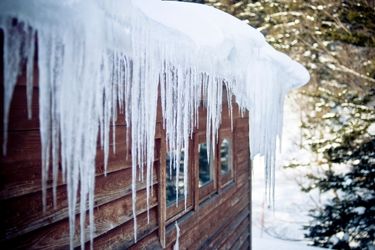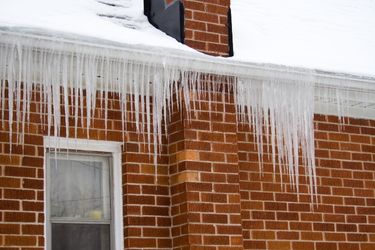
Written by Kayla Jane Barrie Updated on Nov 24, 2025 5 mins read

The two biggest issues during winter for homeowners are snow and ice damming. Over the last few years, many Canadians are learning that ice damming claims may not be included in their policy.
In 2019, CBC reported that an area between Sudbury and Ottawa had five times as many ice dam reports compared to the year before. SGI Canada found in early 2014 they received 2,600 ice dam claims that year – compared to just 28 claims reported in 2012 – that cost $21.7 million!
Prevention is the crucial factor in limiting damage from ice dams, but winter brings unpredictable weather and claims. Here’s what you need to know about how ice dams happen, prevention methods, and how to handle home insurance if damages occur.
Ice damming forms when snow on the roof melts and refreezes at the edge, creating a dam that blocks water from draining off. This can lead to severe roof damage and damage to your gutters. They can also cause water to flow down into your home, ruining the ceiling and wall surfaces; damages that will need additional water damage insurance.
Ice damming is a threat because where the water pools and re-freezes creates a barrier that prevents water from draining away from your house. This can cause water to leak through your roof, and into your home and lead to damage to your ceiling and walls.
They can also pose a threat to people and the exterior of your home. If ice dams break, they can damage gutters, shingles, and siding. There is also the chance ice could fall off the roof and damage your car or other items in your driveway.
Ice damming is caused by a combination of weather conditions, poor insulation, and ventilation in your attack. When the snow melts, it runs down to a cooler area on your roof and eventually re-freezes. Large ice dams can be very heavy and pose a risk to people and your home (such as water reaching your electrical system).
Poor insulation can contribute to the formation of ice dams by allowing warm air from inside your home to rise into the attic, in turn, melting the snow on your roof. The ice begins to back up under the roof shingles, melts again, and can leak into the attic. From there it can leak into insulation and your living space.
You’ll know you have ice damming if you notice :

Although ice damming is not talked about commonly talked about, in recent years it has become a more popular topic for homeowners and insurers. Here are some facts and stats about ice dams :
Even with the best efforts, ice dams can happen. It's important to understand your policy and what it covers when it comes to ice dam damage. Not all policies will include repairs from ice dams. This means any roof replacements, interior walls, or other related problems will need to be paid out of pocket by the homeowner.
Depending on what is outlined in your home insurance, ice dam removal or damages might be covered. It is highly recommended to check with your insurer. They may suggest you upgrade to additional coverage such as overland water insurance to protect you from any potential threats of ice or melting snow.
It's important to keep in mind that repairs to structures around your property, such as pools, patios, fences, or decks may not be covered if the damage is caused by snow or ice dams.
Preventing ice dams is key to avoiding damage to your home. Here are a few steps you can take to reduce the risk of ice dams forming :
Roof rakes have a wide aluminium head attached to an extendable pole. The pole is usually long enough to clear snow from the ground level, so you don’t need to worry about getting a ladder. Depending on the height of your roof, you may require a professional.
If you use a roof rake correctly, it can prevent ice damming. It’s not usually necessary because most homes are designed to support up to five feet of snow accumulation.
An additional method to prevent ice dams is with electric heat cables along the gutters and edge of the roofline. Heat cables can prevent the melting of water from freezing when it reaches the area – the water will flow to the ground. Be sure to hire a professional or follow the manufacturer’s directions precisely to limit accidents.
If you do have an ice dam, it's important to have it removed as soon as possible to prevent further damage to your home. Although there are tips to prevent ice dams, they often need a professional to have them removed safely. For example, chipping can cause damage to your roof or shingles, and ice melt can also lead to further issues. A professional ice dam removal company will have the proper equipment and experience to remove it safely and effectively from your roof.
Gutters do not cause ice dams, but because the water freezes there, it is where they form. To prevent ice dams in your gutters, ensure they are clear of any debris. This will limit how much standing water is present and limit the chance of freezing. Proper ventilation and insulation in your roof will also limit the chance of ice dams forming.
You can place a claim for ice damage from damming. If you place a claim for ice damages with your home insurance, make sure you have enough documentation of damages and keep receipts for repairs, replacements, or removals. Documentation of any preventative measures you’ve taken can also be helpful for the process.
Most ice dams are caused by poor ventilation because the snow melts and re-freezes around gutters and shingles. Clogged gutters and debris can also lead to ice dam formation. Proper maintenance can limit the chance of ice dams forming on your property.
Make sure your home is properly insulated so that the temperature of your roof stays consistent with the eaves. You may need to upgrade the insulation in your attic and add ventilation.
Look closely at your roof and gutters - if you notice any large icicles with ice build-up, it can lead to an ice dam. You’ll also want to look inside your attic and along the ceiling, if your roof for any signs of water stains or moisture.
Ice dams can cause significant damage to your home, but by understanding their causes and taking preventative measures, you can reduce the risk of any damage. Take time to contact your insurer to confirm what’s included with home insurance in Ontario. Severe winter weather can catch us off guard and lacking proper coverage for specific perils can be costly.
| Categories | Home |
|---|---|
| Tags | Home MaintenanceHomeowners ClaimsSeasonal Home |
Read our insurance blog to get helpful tips, information and news.
Has your car been totalled in an accident? Is your car a write off? Learn about vehicle write offs for a total loss insurance claim.
Get the facts on Toronto's auto theft problem. We break down the data, reveal the most-stolen vehicles (including the Honda CR-V and Lexus RX 350), and show which neighbourhoods are most affected.
Dive into the world of auto theft with our blog on the most stolen cars in Canada. See the most stolen cars across Canada, including provincial lists for Ontario and Quebec, and learn how high-risk models can affect your car insurance premiums.
Drive safe this winter! Check out these tips for driving in snowy and icy conditions in Ontario. Get other helpful info and FAQs on winter driving.